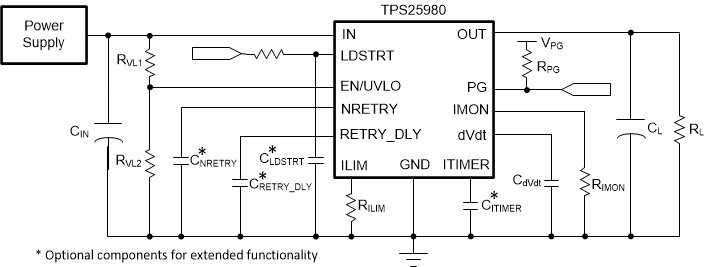JAJSJ14 August 2020 TPS25980
PRODUCTION DATA
- 1 特長
- 2 アプリケーション
- 3 概要
- 4 Revision History
- 5 Device Comparison Table
- 6 Pin Configuration and Functions
- 7 Specifications
-
8 Detailed Description
- 8.1 Overview
- 8.2 Functional Block Diagram
- 8.3 Feature Description
- 8.4 Fault Response
- 8.5 Device Functional Modes
-
9 Application and Implementation
- 9.1 Application Information
- 9.2
Typical Application: Patient Monitoring System in Medical Applications
- 9.2.1 Design Requirements
- 9.2.2
Detailed Design Procedure
- 9.2.2.1 Device Selection
- 9.2.2.2 Setting the Current Limit Threshold: RILIM Selection
- 9.2.2.3 Setting the Undervoltage Lockout Set Point
- 9.2.2.4 Choosing the Current Monitoring Resistor: RIMON
- 9.2.2.5 Setting the Output Voltage Ramp Time (TdVdt)
- 9.2.2.6 Setting the Load Handshake (LDSTRT) Delay
- 9.2.2.7 Setting the Transient Overcurrent Blanking Interval (tITIMER)
- 9.2.2.8 Setting the Auto-Retry Delay and Number of Retries
- 9.2.3 Application Curves
- 9.3 System Examples
- 10Power Supply Recommendations
- 11Layout
- 12Device and Documentation Support
- 13Mechanical, Packaging, and Orderable Information
3 概要
TPS25980x ファミリの eFuse は、小さなパッケージに搭載され、高度に統合された回路保護および電力管理ソリューションです。これらのデバイスは、広い入力電圧範囲で動作します。I*R 電圧降下を最小限に抑える必要がある低電圧システムから、低消費電力を必要とする、より高電圧の大電流システムまで、1 つの部品で対応できます。これらのデバイスは、過負荷、短絡、電圧サージ、過剰な突入電流に対する堅牢な保護素子です。
過電圧事象は内部のカットオフ回路により制限されます。過電圧スレッショルドを選択できるように、複数のデバイス・オプションが用意されています。
このデバイスは、過電流状態に対してサーキット・ブレーカ応答を提供します。過電流制限 (サーキット・ブレーカ・スレッショルド) および高速トリップ (短絡) スレッショルドは、1 つの外付け抵抗で設定できます。これらのデバイスは、過渡事象と実際のフォルトとを識別して、過電流応答をインテリジェントに管理するので、フォルトに対する保護の堅牢性を損なわずに、システムはライン過渡や負荷過渡の間も中断なく動作できます。デバイスは、フォルト・シャットダウン後、ラッチ・オフに維持されるか、または自動的に再試行を行うかを設定可能です。自動再試行の回数や再試行の間隔は、コンデンサで設定できます。これによって、リモート・システムは一時的なフォルトから自動的に復元できるとともに、持続的なフォルトが原因で電源にいつまでもストレスがかかることがないようになります。
TPS25980x デバイスは、小型の 4mm × 4mm QFN パッケージで供給されます。これらのデバイスは、-40℃~125℃の接合部温度範囲で動作が規定されています。
| 部品番号 | パッケージ | 本体サイズ (公称) |
|---|---|---|
| TPS25980x | QFN (24) | 4.0mm × 4.0mm |
 概略回路図
概略回路図